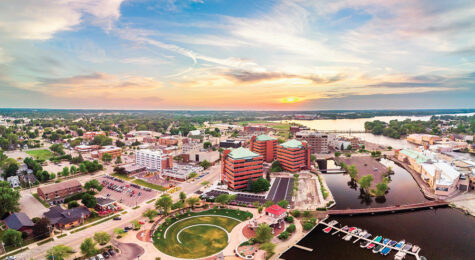Bird City Takes Flight in Wisconsin
Communities take action to protect birds, preserve habitat

Wisconsin is for the birds. Literally.
A growing collection of communities in the Badger State have committed to take steps to conserve bird populations, including several that have seen sharp declines. An organization called Bird City Wisconsin, modeled after The Arbor Day Foundation’s Tree City USA, recognizes municipalities that agree to preserve or create habitat for birds, conduct public education and awareness campaigns about the conservation of birds, and hold a celebration marking International Migratory Bird Day, among other things. So far, 88 communities have been recognized by Bird City. Similar programs are being explored in Minnesota and Iowa, while Bird Town Indiana was closely modeled after Wisconsin’s program.
Bird City Wisconsin (not to be confused with the actual town of Bird City in Kansas or the private wildfowl refuge and sanctuary off the coast of Louisiana) took flight in late 2009 thanks to a grant from TogetherGreen. Bryan Lenz, Ph.D., serves as Bird City’s director and is the program’s lone paid employee. A seven-member steering committee is composed of individuals from a variety of conservation-minded groups who dedicate their time to the project. Bird City Wisconsin is a program overseen by the Milwaukee Audubon Society.
Benefits of Birds
Bird populations across the country have been on the decline. Take for example a 32.3 percent drop in the number of Chimney Swifts and a 92.7 percent decline in Purple Martin populations in Wisconsin over the past 40 years. More than 2 billion birds are killed by American cats each year, according to Lenz, and the Bird Conservation Network claims that more than 100 million birds are killed by collisions with windows in the U.S.
“Watching birds provides people with a connection to the natural world that is often lacking in modern society,” Lenz says. “For the 80 percent of Americans who live in urban settings, watching birds is the easiest way to observe wild animals and feel like a part of the natural world.”
Bird conservation also brings economic benefits. According to the U.S. Fish and Wildlife Service, birdwatchers spent more than $40 billion on trips and equipment that generated nearly $107 billion in total industry output during 2011. Birdwatching supports 666,000 jobs and helped pay $13 billion in local, state and federal taxes.
Bird Protection Is Key
Lenz says habitat preservation and building public awareness are extremely important for communities that want to protect birds. Cities that receive Bird City recognition get street signs to put up, flags and a plaque, in addition to marketing support from Bird City. Protecting birds has caught on quickly in Wisconsin. Twenty communities were recognized as “bird cities” by 2011, and that number jumped to 73 in 2013.
“Our conservation model is not proprietary,” Lenz says. “We welcome any state that would like to try and replicate our success. Our primary goal is to build healthy bird and human communities, and we are happy to provide any assistance we can to other states that would like to join us.”


